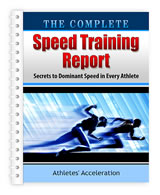Speed Training: Arm ActionThe arms play a significant, yet overlooked, role in sprinting and speed development. Without specifically and regularly addressing proper arm mechanics within your speed training program, full speed potential will not be realized. Today we will address this issue so that we can continue to make improvements on the athletic field. The role of the arms is to stabilize the torso so that power can continue to be efficiently transferred through the hips. It is this ability to transfer power effectively through the center of mass that not only improves rate of acceleration, but also facilitates reaching maximum velocity, maintaining those top speeds and reducing the rate of deceleration. So, as you can see, the arms both directly and indirectly influence the ability to run fast. Now let's get into the specifics of improving our arm action. When running, it's very important to keep your hands relaxed. Think about holding a potato chip in each hand. No matter how hard you run, no matter how tired you get, you can't clench your hands so that the potato chip breaks. This is a good way of thinking about how loose your hands should be at all times when running. When you start to clench your fists tightly, that tightness spreads like through your forearms, biceps, shoulders, neck and face. Once you tighten up and lose range of motion in your arms, it reduces stride length, which is difficult to get back without burning a lot of energy. While sprinting, it is important to get a full range of motion with the arms. Remember, speed is a product of stride length and stride frequency. Stride length and frequency are determined, in part, by the motion of the arms. If you are lazy or passive with your arm action, you are limiting your potential for speed.
Your front arm angle should be between 60-90 degrees at the elbow and your back arm should be between 90-120 degrees, also at the elbow. If your arm angles fall outside of this range, your running mechanics will be negatively affected. In short, you'll run slower and get tired faster. When running, arm swing should be initiated at and through the shoulders. You should think of your elbow as being locked in place. Elbow angle should only change slightly, as a result of elastic response. Range of motion with the arms should generally be hip to cheek. That is, the hand clears the hip in the back and comes up to about cheek height in front. Much more than that, in either direction, will result in over striding which, as mentioned before, will cause breaking and can lead to strains, pulls and tears in the muscle. When running, emphasis should be placed on driving the elbows down and back. When runners fire their arms straight back, without first driving them down, it often leads to bunched up shoulders, which causes tightness and limits range of motion. It is important to focus on driving the arms back as they are recovered elastically by the stretch of muscles in the shoulder. So, don't drive your arms up and forward because stretch reflex is going to bring them forward anyway. Another aspect of arm action is to avoid lateral deviation beyond the saggital plane. What this means is that your arms, when they are brought in front of you, should never cross the midline of your body. Your right arm should stay on the right half of your body and your left arm should stay on the left side. When you move your arms laterally, across the midline of your body, you rotate your hips which basically burns much needed energy and makes you run slower and get tired faster, all for no reason other than laziness and lack of concentration. Remember, you compete like you practice, so if you don't correct technical issues in practice, you can't expect them to be fixed in competition. SAMPLE EXERCISE Stand with the feet between hip and shoulder width apart. Bring your weight forward onto the balls of the feet. You should be far enough forward that your heels are slightly off the ground, but not so far forward that your toes curl to maintain balance. It is this slight, 2- 4 degree lean, that is ideal for simulating sprinting. Start with one arm forward, 90 degrees at the elbow and one arm back, also 90 degrees at the elbow. Perform this drill following the guidelines presented in this article. Arm action at 50% intensity Arm action at 80% intensity Arm action at 100% intensity Get More Information on the Ultimate Speed Training Resource by
Related Articles: Speed Training Drills | Speed Training: Arm Action Drill | Warm up Drills | 3 Speed Drills You Should Never Use | 'A' March Drill | 'A' Skip Drill | 'A' Run Speed Drill | Fast Leg Drill | Sprinting - Mechanical problems | Dynamic Warm-up Speed Drills
|
|||||
